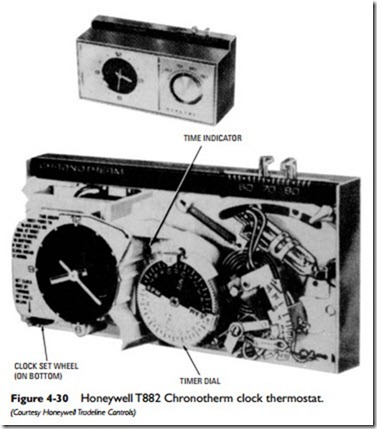Insertion Thermostats
An insertion thermostat is used primarily to measure the air temperature in a duct. The thermostat is mounted on the outside of the
air duct with the sensing element extending inside. Because of this application, it is sometimes referred to as a duct thermostat. Remote-bulb-type thermostats are also used to measure the air temperature in ducts.
Immersion Thermostats
An immersion thermostat is commonly used for water temperature control in an automatic gas-fired water heater (see Figure 4-32). This is usually a direct, snap-action, bimetallic thermostat in which contraction of the thermal element immersed in the stored hot water causes the main gas valve to open. This occurs when there is a drop in the temperature of the water in the storage tank. Expansion of this element serves to close the main gas valve when the tank water attains the selected predetermined temperature.
These thermostats normally operate at a temperature differential of approximately 12F° . In other words, if the thermostat is set to shut off the gas to the main burner when the tank water temperature reaches 140F° , it will react to open the valve when the temperature drops to 128F° .
Quite often, an immersion water heater thermostat will be included in a combination control. These combination controls used in water heaters are described in Chapter 4 of Volume 3(W“ ater Heaters and Other Appliances).

